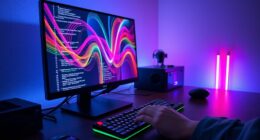To enhance your improvisation skills, focus on creative exercises like inventing stories from objects or creating melodies from single notes, which strengthen quick thinking and spontaneity. Practice developing core storytelling elements such as characters, conflict, and resolution to keep your performances cohesive. Collaborate actively with others through turn-taking and responsive improvisation to build seamless interactions. By mastering principles like authentic expression and adaptability, you open new creative freedom—discover more ways to elevate your craft as you continue exploring.
Key Takeaways
- Practice spontaneous storytelling by inventing narratives from everyday objects or random prompts.
- Use core storytelling elements like character, conflict, and resolution to guide improvised performances.
- Engage in collaborative exercises such as turn-taking to develop active listening and seamless idea integration.
- Incorporate creative prompts, melodies, or motifs to foster spontaneity and thematic coherence.
- Apply principles like Design Thinking to anticipate audience reactions and adapt performances dynamically.

Have you ever wondered how performers create spontaneous, enthralling moments on stage? The secret often lies in their mastery of storytelling methods and the use of creative exercises that sharpen their instincts. For writers and musicians alike, improvisation isn’t just about reacting in the moment; it’s about developing a toolkit of techniques that foster quick thinking and genuine expression. By exploring different storytelling methods, you can learn to craft compelling narratives on the fly, whether you’re composing a song or writing a scene. These methods encourage you to think beyond the script and embrace unpredictability, making each performance unique and captivating.
Engaging in creative exercises is a great way to build your improvisational skills. For example, you might challenge yourself with prompts that push you out of your comfort zone, like inventing a story based on a random object or starting a melody with a single note. Such exercises train your brain to think creatively under pressure, helping you develop fluency and confidence. They also improve your ability to listen and respond in real time — essential skills for improvising effectively. When you regularly practice these techniques, you start to see opportunities for spontaneity everywhere, transforming your approach to both writing and music.
Creative exercises like prompts and improvisation boost your spontaneity and confidence in writing and music.
Incorporating storytelling methods into your practice involves understanding the core elements of a good story: characters, conflict, and resolution. Even when improvising, keeping these elements in mind can guide your creative process. For writers, this might mean creating quick backstories for characters or imagining different plot twists on the spot. Musicians can apply similar principles by developing themes or motifs that evolve naturally during a performance. These methods help you stay grounded amid improvisation’s unpredictability, ensuring you’re still telling a compelling story or creating an emotionally resonant piece, even in the moment.
Another effective approach is to participate in improvisation exercises that emphasize collaboration. Whether you’re working with other writers or musicians, these exercises teach you to listen actively and adapt your ideas seamlessly. For instance, you might take turns adding lines to a story or building melodies together, each person responding to what’s been created before. This not only boosts your creativity but also enhances your ability to maintain momentum and stay present. Over time, these practices become second nature, empowering you to craft engaging, spontaneous performances that captivate audiences.
Additionally, understanding the principles of Design Thinking can help you approach improvisation with a more structured and user-centered mindset, allowing you to better anticipate audience reactions and adapt your performance accordingly. Ultimately, mastering improvisation techniques through storytelling methods and creative exercises unblocks a new realm of artistic freedom. It encourages you to trust your instincts, embrace the unexpected, and find joy in the process of creation. Whether on stage or behind the page, these tools help you become more responsive, authentic, and dynamic in your craft. The more you practice, the more natural improvisation feels, transforming your work into genuine moments of connection and inspiration.
Frequently Asked Questions
How Can Beginners Start Practicing Improvisation Effectively?
To start practicing improvisation effectively, you should focus on mindfulness exercises to clear your mind and stay present. Begin with structured improvisation exercises, such as playing simple scales or prompts, and let yourself experiment without judgment. Gradually increase complexity, paying attention to your instincts. Regular practice helps build confidence and spontaneity, making improvisation feel more natural and enjoyable over time.
What Are Common Mistakes to Avoid During Improvisation?
You must dodge the colossal trap of improvisation anxiety, which can freeze your creativity like a statue. Avoid overreliance on clichés, as they strip your work of originality and charm. Don’t panic or try to control every note or word—improvisation thrives on spontaneity. Keep your mind open, embrace mistakes as part of the process, and trust your instincts to craft authentic, compelling improvisations that shine with personality.
How Do Improvisation Techniques Differ Between Writers and Musicians?
You’ll find that improvisation techniques differ between writers and musicians by emphasizing creative spontaneity and expressive freedom. As a writer, you often explore ideas through free-flowing writing, trusting your intuition to develop narratives. Musicians, on the other hand, focus on spontaneous melodies and rhythms, using their instrument’s voice for expressive freedom. While both rely on improvisation, writers craft words, and musicians craft sounds, each embracing their unique form of spontaneity.
Can Improvisation Improve Overall Creativity and Problem-Solving Skills?
Yes, improvisation can boost your creativity and problem-solving skills. It builds creative confidence, encouraging you to take risks and trust your instincts. While it enhances cognitive flexibility, helping you adapt to new ideas and challenges quickly. Like a jazz solo or spontaneous story, improvisation pushes you beyond comfort zones, sharpening your ability to think on your feet and find innovative solutions in both artistic and everyday situations.
What Tools or Resources Can Enhance Improvisation Practice?
You can enhance your improvisation practice with digital apps like iReal Pro or GarageBand, which offer versatile tools to experiment and develop your skills. Participating in jam sessions also boosts your spontaneity and adaptability, giving you real-time feedback and inspiration. These resources help you stay motivated, refine your techniques, and build confidence as you explore new ideas and push creative boundaries during your improvisation practice.
Conclusion
By embracing improvisation techniques, you open your creative potential and overcome writer’s block or musical hesitation. Did you know that 85% of successful writers and musicians credit improvisation as a key to their breakthroughs? So, next time you feel stuck, trust your instincts and experiment freely. Remember, improvisation isn’t about perfection—it’s about discovery. Keep practicing, stay open-minded, and watch your creativity flourish beyond what you thought possible.








